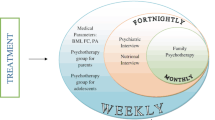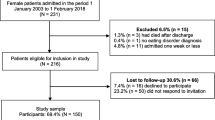Abstract
Objective
There is evidence for an increased prevalence and an earlier onset of anorexia nervosa (AN) in adolescents. Early specialized treatment may improve prognosis and decrease the risk of a chronic course. The current study evaluates the effectiveness of a multimodal inpatient treatment for adolescent AN patients treated in a highly specialized eating disorder unit for adults.
Method
177 adolescents and 1,064 adult patients were included. The evaluation focused on eating behavior, depressive symptoms and general psychopathology.
Results
All measured variables decreased significantly in both groups during inpatient treatment. No differences were found concerning weight gain, improvement of global eating disorder symptomatology as well as depressive symptoms. However, adults showed a higher psychological distress and in this regard also a greater improvement.
Conclusion
Results indicate that treating adolescent AN patients in a highly specialized eating disorder unit for adults can be an effective treatment setting for these patients.
Similar content being viewed by others
References
Padierna A, Quintana JM, Arostegui I, Gonzalez N, Horcajo MJ (2000) The health-related quality of life in eating disorders. Qual Life Res 9(6):667–674
Engel SG, Adair CE, Las Hayas C, Abraham S (2009) Health-related quality of life and eating disorders: a review and update. Int J Eat Disord 42(2):179–187
Harris EC, Barraclough B (1998) Excess mortality of mental disorder. Br J Psychiatry 173:11–53
Herpertz-Dahlmann B, Salbach-Andrae H (2009) Overview of treatment modalities in adolescent anorexia nervosa. Child Adolesc Psychiatric Clin N Am 18(1):131–145
Lock J, Fitzpatrick KK (2009) Advances in psychotherapy for children and adolescents with eating disorders. Am J Psychother 63(4):287–303
Wilson GT, Grilo CM, Vitousek KM (2007) Psychological treatment of eating disorders. Am Psychol 62(3):199–216
le Grange D, Lock J (2005) The dearth of psychological treatment studies for anorexia nervosa. Int J Eating Disord 37(2):79–91
Kennedy S, Kaplan AS, Garfinkel PE (1992) Intensive hospital treatment of anorexia nervosa and bulimia nervosa. In: Cooper P, Stein A (eds) Feeding problems and eating disorders in children and adolescents monographs in clinical pediatrics. Harwood Academic Publishers, New York, pp 161–182
Rome ES, Ammerman S, Rosen DS, Keller RJ, Lock J, Mammel KA et al (2003) Children and adolescents with eating disorders: the state of the art. Pediatrics 111(1):e98–e108
Gowers SG, Clark AF, Roberts C, Byford S, Barrett B, Griffiths A et al (2010) A randomised controlled multicentre trial of treatments for adolescent anorexia nervosa including assessment of cost-effectiveness and patient acceptability—the TOuCAN trial. Health Technol Assess 14(15):1–98
Herpertz-Dahlmann B, Wille N, Holling H, Vloet TD, Ravens-Sieberer U (2008) Disordered eating behaviour and attitudes, associated psychopathology and health-related quality of life: results of the BELLA study. Eur Child Adolesc Psychiatry 17(Suppl 1):82–91
Steinhausen H-C (1985) Evaluation of inpatient treatment of adolescent anorexic patients. J Psychiatr Res 19(2–3):371–375
Steinhausen H-C, Seidel R (1993) Outcome in adolescent eating disorders. Int J Eat Disord 14(4):487–496
Herpertz S, Herpertz-Dahlmann B, Fichter M, Tuschen-Caffier B, Zeeck A (2011) S3-Leitlinie Diagnostik und Behandlung der Essstörungen. Springer, Berlin
Heinberg LJ, Haug NA, Freeman LMY, Ambrose D, Guarda AS (2003) Clinical course and short-term outcome of hospitalized adolescents with eating disorders: the success of combining adolescents and adults on an eating disorders unit. Eating Weight Disord 8(4):326–331
Fichter MM, Quadflieg N (2000) Comparing self- and expert rating: a self-report screening version (SIAB-S) of the Structured Interview for Anorexic and Bulimic Syndromes for DSM-IV and ICD-10 (SIAB-EX). Eur Arch Psychiatry Clin Neurosci 250(4):175–185
Franke GH (2000) BSI: brief symptom inventory von L. R. Derogatis (Kurzform der SCL-90-R)—Deutsche Version. Beltz Test, Göttingen
Franke G (1995) SCL-90-R. Die Symptom-Checkliste von Derogatis—Deutsche Version. Beltz Test, Göttingen
Hautzinger M, Bailer M, Worall H, Keller F (1994) Beck-Depressions-Inventar (BDI). Verlag Hans Huber, Bern
Teri L (1982) The use of the Beck Depression Inventory with adolescents. J Abnorm Child Psychol Off Publ Int Soc Res Child Adolesc Psychopathol 10(2):277–284
Tabachnik BG, Fidell LS (2006) Using multivariate statistics. Harper Collins College Publishers, New York
Buehner M, Ziegler M (2009) Statistik für Psychologen und Sozialwissenschaftler. Pearson Studium, Muenchen
Kessler R, Glasgow RE (2011) A proposal to speed translation of healthcare research into practice: dramatic change is needed. Am J Prev Med 40(6):637–644
Saccomani L, Savoini M, Cirrincione M, Vercellino F, Ravera G (1998) Long-term outcome of children and adolescents with anorexia nervosa: study of comorbidity. J Psychosom Res 44(5):565–571
Gowers S, Bryant-Waugh R (2004) Management of child and adolescent eating disorders: the current evidence base and future directions. J Child Psychol Psychiatry 45(1):63–83
Fisher M, Golden NH, Katzman DK, Kreipe RE, Rees J, Schebendach J et al (1995) Eating disorders in adolescents: a background paper. J Adolesc Health 16(6):420–437
Agras WS, Brandt HA, Bulik CM, Dolan-Sewell R, Fairburn CG, Halmi KA et al (2004) Report of the National Institutes of Health workshop on overcoming barriers to treatment research in anorexia nervosa. Int J Eat Disord 35(4):509–521
Halmi KA, Agras WS, Crow S, Mitchell J, Wilson GT, Bryson SW et al (2005) Predictors of treatment acceptance and completion in anorexia nervosa: implications for future study designs. Arch Gen Psychiatry 62(7):776–781
Steinhausen HC (1997) Annotation: outcome of anorexia nervosa in the younger patient. J Child Psychol Psychiatry 38:271–276
Steinhausen H-C, Grigoroiu-Serbanescu M, Boyadjieva S, Neumärker K-J, Metzke CW (2008) Course and predictors of rehospitalization in adolescent anorexia nervosa in a multisite study. Int J Eat Disord 41(1):29–36
Herpertz-Dahlmann B, Müller B, Herpertz S, Heussen N, Hebebrand J, Remschmidt H (2001) Prospective 10-year follow-up in adolescent anorexia nervosa: course, outcome, psychiatric comorbidity, and psychosocial adaptation. J Child Psychol Psychiatry 42(5):603–612
Ratnasuriya RH, Eisler I, Szmukler GI, Russell GF (1991) Anorexia nervosa: outcome and prognostic factors after 20 years. Br J Psychiatry 158:495–502
Casper R, Jabine LN (1996) An eight year follow up: outcome from adolescent compared to adult onset anorexia nervosa. J Youth Adolesc 25:499–517
Kreipe RE, Dukarm CP (1996) Outcome if anorexia nervosa related to treatment utilizing an adolescent medicine approach. J Youth Adolesc 25:483–497
Conflict of interest
The authors declare that they have no conflict of interest.
Author information
Authors and Affiliations
Corresponding author
Rights and permissions
About this article
Cite this article
Naab, S., Schlegl, S., Korte, A. et al. Effectiveness of a multimodal inpatient treatment for adolescents with anorexia nervosa in comparison with adults: an analysis of a specialized inpatient setting. Eat Weight Disord 18, 167–173 (2013). https://doi.org/10.1007/s40519-013-0029-8
Received:
Accepted:
Published:
Issue Date:
DOI: https://doi.org/10.1007/s40519-013-0029-8




